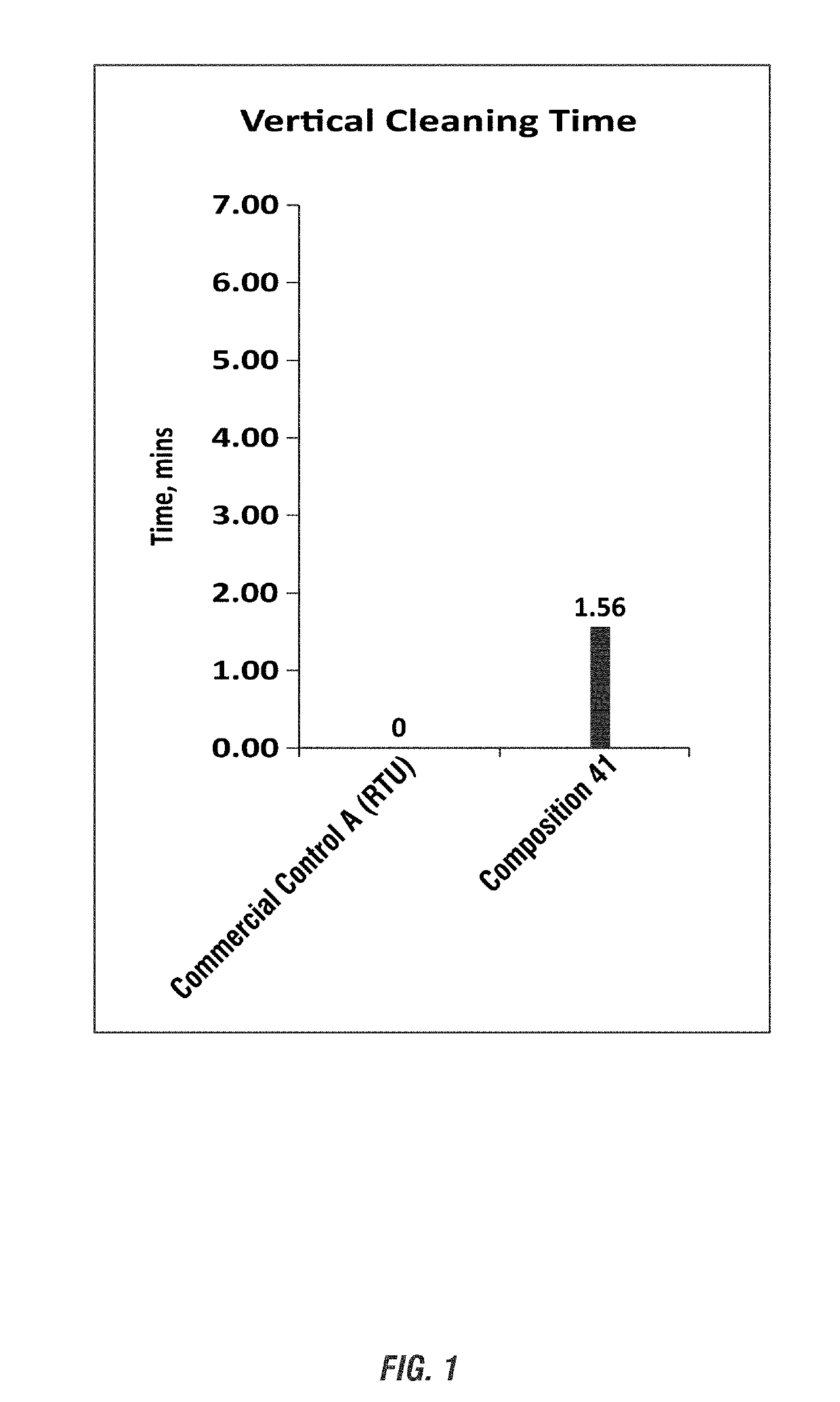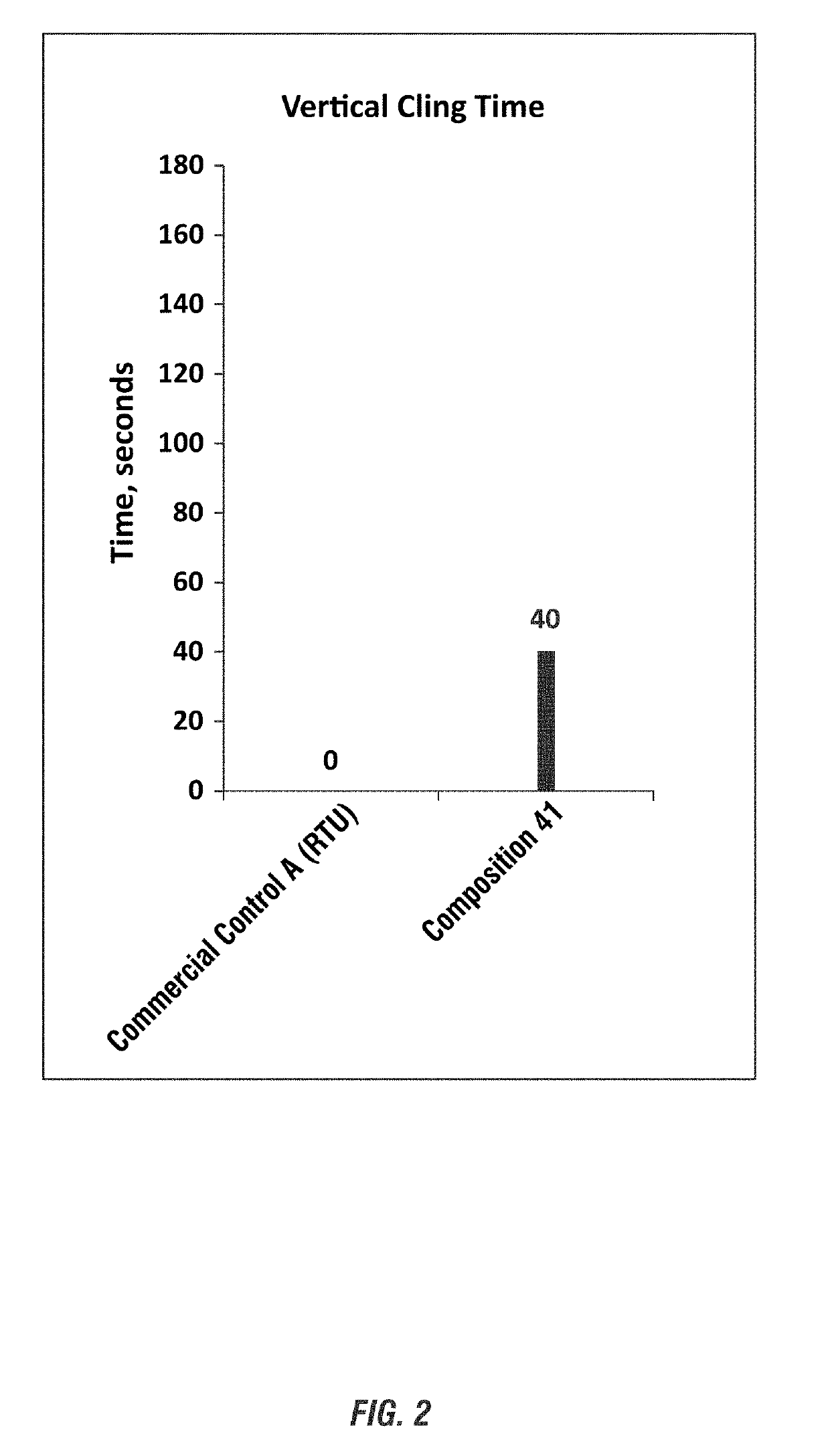Cleaning compositions and methods for removing baked on grease from fryers and other hot surfaces
- Summary
- Abstract
- Description
- Claims
- Application Information
AI Technical Summary
Benefits of technology
Problems solved by technology
Method used
Image
Examples
example 1
[0179]Various emulsifiers and rheology modifiers were evaluated through screening tests to determine ability to increase a composition's cling time after the composition is applied to a vertical surface and the time the composition was visible on the surface was recorded. The control formulation listed in Table 3 was used as the starting point and comparison for modified formulations. Different rheology modifiers were added into the control formulation, either alone or in combinations, respectively, and their effects on the compositions' cling times were then observed and evaluated. Based on the initial evaluation a polysaccharide material, hydroxyethyl cellulose, was selected for further evaluation.
[0180]The Control was compared to an evaluated formula containing the hydroxyethyl cellulose as a rheology modifier to thicken the composition and beneficially increase cling time for the composition to contact a soiled surface. Formula 26 (a RTU composition shown in Table 4H without fur...
example 2
[0181]Various agents for improving emulsification were also evaluated. A simple setup for evaluating an emulsification agent was set up by using individual glass vials with lids to house both an evaluated chemistry and oils for emulsification. Control, and Formulas 1-4 were evaluated by placing 2% experimental composition inside a vial before vegetable oil (soybean) was added slowly on the top of the oil followed by two drops of a 1% solution of water and a soluble blue dye. After the liquids were mixed well the height of the aqueous layer was recorded at a series of time points. The heights of the aqueous layer 23 seconds and approximately 7 minutes (6 minutes 58 seconds) after shaking the vials were observed. The water soluble blue dye was used in the experiment to enhance the visual effect.
[0182]Visual observation of the differences in the heights of the aqueous bottom layer of each sample were made. In addition, the height of the emulsification layer was recorded at a series of ...
example 3
[0184]Various fryer cleaning compositions were made and evaluated for cling time, emulsification effects, and cleaning time. Table 3 lists the ingredients of the Control composition. Tables 4A-4J lists the ingredients of the various evaluated fryer cleaning compositions. Table 5 summarizes the evaluation results and comparison of the various evaluated fryer cleaning compositions.
TABLE 3Control FormulationQuantity, Wgt. %Description82.7Water3-6Alkalinity sources includingMonoethanolamine 99% IBC1-3Wetting agent / surfactant 8-10Benzyl alcohol solvent
TABLE 4AExemplary Formulations for Evaluating Cling Time, Emulsification, Cleaning TimeFormula 1Formula 2Formula 3Formula 4DescriptionWgt., gWgt., %Wgt., gWgt., %Wgt., gWgt., %Wgt., gWgt., %Water Zeolite78.4678.4378.4678.4683.9583.9184.2784.23Softened TNKNatrosol 250 HR0.940.940.520.520.530.530.750.75Monoethanolamine4.514.514.564.563.543.544.034.03Dodecylbenzene2.802.802.842.842.662.662.252.25Sulfonic Acid 96%IBC (LAS)Sodium Dioctyl1.361.36...
PUM
 Login to View More
Login to View More Abstract
Description
Claims
Application Information
 Login to View More
Login to View More - R&D
- Intellectual Property
- Life Sciences
- Materials
- Tech Scout
- Unparalleled Data Quality
- Higher Quality Content
- 60% Fewer Hallucinations
Browse by: Latest US Patents, China's latest patents, Technical Efficacy Thesaurus, Application Domain, Technology Topic, Popular Technical Reports.
© 2025 PatSnap. All rights reserved.Legal|Privacy policy|Modern Slavery Act Transparency Statement|Sitemap|About US| Contact US: help@patsnap.com



